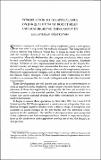| dc.contributor.author | Osterman, Paul | |
| dc.date.accessioned | 2017-01-09T20:16:04Z | |
| dc.date.available | 2017-01-09T20:16:04Z | |
| dc.date.issued | 2013-07 | |
| dc.identifier.issn | 0019-7939 | |
| dc.identifier.issn | 2162-271X | |
| dc.identifier.uri | http://hdl.handle.net/1721.1/106304 | |
| dc.description.abstract | Scholars, employers, and certainly many employees share a perception that how work is organized has radically changed. The long period of relative stability that followed World War II began to erode in the 1970s with the multiple shocks of the oil crisis and accelerating international competition. Many also believe that the computer revolution, which transformed possibilities for managing firms and work processes, hastened change. Diffusion of new organizational models such as the Toyota Production system, not simply into automobiles but into a wide range of service as well as manufacturing industries, also remade employment systems. Distinctive organizational designs, such as the networked model found in the Silicon Valley, emerged. Firms redefined their relationship to their workforce as witnessed by the rise of contingent work and reduced mutual commitment.
These developments are well known and add up to a transformation of work as experienced by employees. What is much less understood is the implication of these developments for job quality. We have yet to arrive at a coherent answer to this essential question. Nor do we understand how outcomes vary across national settings that differ substantially in their labor market institutions.
To begin to answer these questions, in November 2011 the Cornell ILR School and the ILR Review sponsored a conference on job quality. That conference brought together scholars from a diverse range of disciplines and countries to assess changes in the job market and the attendant consequences for the workforce. The articles in this special issue were presented at the conference and have subsequently been revised in response to discussions at the conference and suggestions coming out of the ILR Review's review process. | en_US |
| dc.language.iso | en_US | |
| dc.publisher | Sage Publications | en_US |
| dc.relation.isversionof | http://dx.doi.org/10.1177/001979391306600401 | en_US |
| dc.rights | Article is made available in accordance with the publisher's policy and may be subject to US copyright law. Please refer to the publisher's site for terms of use. | en_US |
| dc.source | Industrial and Labor Relations Review | en_US |
| dc.title | Introduction to the Special Issue on Job Quality: What Does it Mean and How Might We Think about It? | en_US |
| dc.type | Article | en_US |
| dc.identifier.citation | Osterman, Paul. “Introduction to the Special Issue on Job Quality: What Does It Mean and How Might We Think About It?” ILR Review vol. 66, no. 4, 2013, pp. 739–752. © 2016 Cornell University | en_US |
| dc.contributor.department | Sloan School of Management | en_US |
| dc.contributor.mitauthor | Osterman, Paul | |
| dc.relation.journal | ILR Review | en_US |
| dc.eprint.version | Final published version | en_US |
| dc.type.uri | http://purl.org/eprint/type/JournalArticle | en_US |
| eprint.status | http://purl.org/eprint/status/PeerReviewed | en_US |
| dspace.orderedauthors | Osterman, Paul | en_US |
| dspace.embargo.terms | N | en_US |
| dc.identifier.orcid | https://orcid.org/0000-0002-1210-7820 | |
| mit.license | PUBLISHER_POLICY | en_US |
